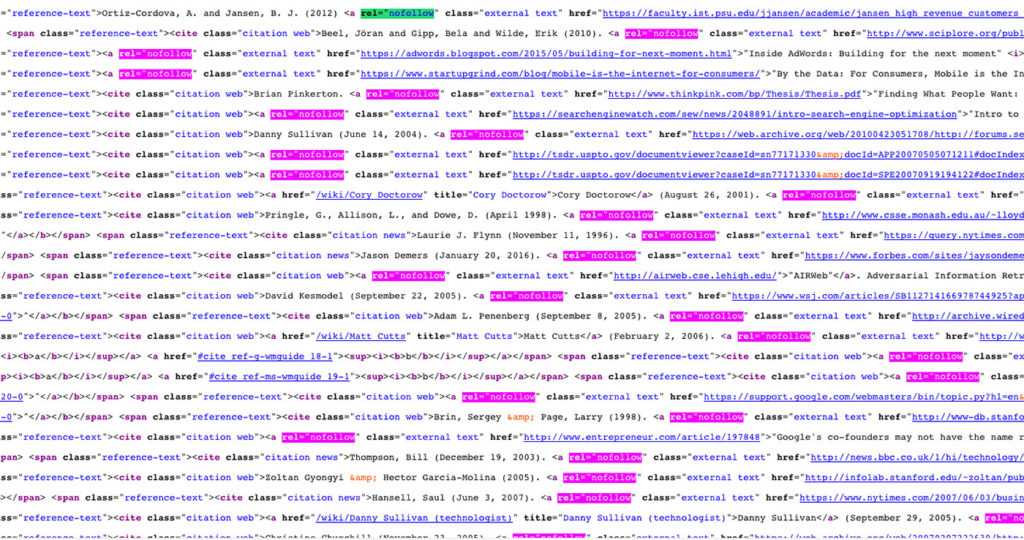Today we are going to be talking about link building. Link building is when you get other outside websites to link back to your site. The issue is there are two types of links, dofollow vs nofollow links… so what’s the difference? In this article, we’ll go over the difference between the two, and explain exactly when you would want to use one over the other.
If this sounds like something highly technical… don’t worry it really isn’t.
Even though the lingo sounds a bit intimidating, dofollow vs nofollow links are easy to understand. In fact learning about these different types of links is a great way to increase your SEO knowledge and improve your own website.
What is a dofollow link?
A dofollow link is when you link to an outside website and you are telling Google to give credit to this website.
Google pays attention to each and every nofollow link you receive on your website and counts these towards increasing your page rank.
You are essentially vouching that this other website is high quality and in good standing. In the backend code of your site, it looks something like rel=“dofollow.”
By giving a website a dofollow link on your site, you are giving them SEO juice which benefits their website. This other site can get a boost to their page ranking and is more likely to be shown in search results. But don’t think that outbound nofollow links only benefit the other website because this is not the case.
Outbound links are actually really good for your blog articles because they show Google that you have done your research and are willing to cite reputable sources.
It’s always a good idea to link out to high quality websites such as government websites or wikipedia because this makes your own blog articles look stronger in the eyes of Google.
If you take a look at a high traffic website such as Wikipedia you’ll notice their webpages such as this one contain a lot of outbound links.
In fact, in the first paragraph alone, I counted 11 outbound links!
What is a nofollow link?
A nofollow link is a link on a website that tells search engines such as Google not to count.
In other words you are referencing a website, but you aren’t going to give this website SEO link juice.
In the backend code of your site, it looks something like rel=“nofollow.”
There are a couple of reasons why you would want to use a nofollow link on your website.
The first reason would be if you are getting paid to write a review about a product or have been offered a sponsorship. Anytime there is money involved (like an affiliate bonus) you’ll want to be extremely careful never to add a dofollow link because this can put you on Google’s watch list for link schemes.

Basically a link building scheme is when a site adds links to their site that are “intended to manipulate PageRank or a site’s ranking in Google search results.”
Another reason you would want to use a nofollow link is if you don’t believe the other site deserves it. Perhaps you are writing a rant on why a product is so bad or how this other website stole all of your images… in this case you wouldn’t want to give them SEO link juice. This would only benefit their site so it would be better to use a nofollow link.
Are there any benefits of nofollow links?
Yes, actually.
Contrary to popular belief, nofollow links can actually indirectly improve your SEO. Let me explain how.
If you are referenced on another website and the site owner gives you a nofollow link, this is actually a great thing.
This link is seen by readers as a recommendation to check out your website. This is essentially word of mouth marketing at it’s finest. The site owner is saying “check this website out, it’s really cool!”
Readers don’t know it’s a nofollow link, they just see a link and this is amplification for your site.
In essence, if someone clicks on this link, this brings traffic to your site. And if Google sees traffic going to your site, it signals to them that your website is worth visiting (and perhaps worth recommending).
Is buying links bad for SEO?
Yes, always. There are no exceptions to this rule.
Remember that it is never a good idea to buy links.
Paid link insertion is SEO suicide. This is 100% against the Google’s Webmaster rules and can result in a severe penalization of your website.
Although you might think that no one will know about your secret arrangement with another website (that is willing to give you a dofollow link in exchange for money), Google already has a running list of fraudulent websites.
The last thing you want to do for your website is associate with bad websites that are selling links. If Google sees your site linked on a fraudulent website, they’ll assume your website is also shady and they will make sure to bury you in search results.
Common questions
Are external dofollow links to my own site in any way better for my SEO than nofollow ones?
Yes, dofollow links are way better for your SEO than nofollow.
Dofollow links are counted by Google towards your overall SEO score. . Google counts each and every nofollow link that points to your website and this can help your page rank increase significantly.
When you enter a link on your own website, should you use a dofollow or nofollow link?
This depends.
What’s standard practice?
Standard practice for dofollow vs nofollow links is to just default to using dofollow links on your own site. In fact, the popular blog platform WordPress automatically defaults to dofollow for all outbound links you add to your articles. This is the standard convention.
It’s okay to use dofollow links when citing an outside website if you know that they are high quality. In the case that you are referencing a website that did something spammy or illegitimate, you would want to use a nofollow link.
If you have a Shopify store and are writing blog articles for your online business, this platform also defaults to using dofollow links for all outbound links.
So if you want to make your links nofollow on Shopify, you’ll have to manually go in and change them by hand. To do this you’ll just need to click on the little button to “show html.” And in here you’ll need to insert rel=”nofollow” right before the href.
This makes your life easier and headache free because it enables you to focus more on building inbound links and worry less about the back-end code on your own website.
Just something to keep in mind. 😉
Summary
I hope this article was able to shed some light on dofollow vs nofollow links. If you have any more questions feel free to get in touch with us here.
Shopify Success Newsletter
Don't miss out on the best tips and guides for Shopify sellers!


